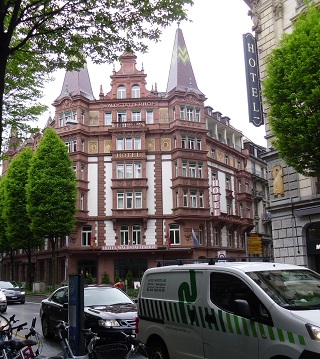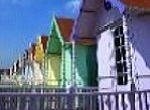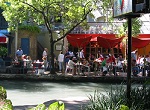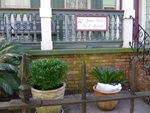Tourism and Economic Development Go Together
Last Updated: December 1, 2025
Tourism and economic development are good partners by the very definition of economic development we use, which is a new activity that generates income from outside sources for your community.
To develop at least a partial connection between tourism and economic development, you'll need these characteristics and facilities.

- At least one tourist attraction, which we define as something a person who does not live in your community would want to see or experience, including scenic areas.
- Supporting retail businesses, including at least one restaurant that's not a smoky local bar, or otherwise so local that an outsider will feel uncomfortable there. In a very small town, a gas station with an ATM machine and a place to buy an anti-acid and a fountain soda is essential.
- Clear wayfinding mechanisms, which might vary from a gaudy but effective billboard on the highway to wonderful graphics and discreet signage within your city or town. Wayfinding also could be a tulip path, public art, or graphic painted on the street, you know.
- Parking and restroom availability and wayfinding to them. Tourism and economic development organizations, or the local government, need to provide them.
- A sense of hospitality and knowledge of tourist attractions in the city/town, especially among individuals most likely to come in contact with tourists.
- Safety enhancements if there is any sense that the tourist attraction might be in an unsafe neighborhood. Activity is the best safety enhancement, but visible law enforcement, escorts to and from cars, or private security greeters could be necessary in the toughest of circumstances.
You cannot take short-cuts on any one of the above. If the person that answers the phone at the inn says there's no maze in town, but there is, you just struck out. This happened to a friend.
You'd be surprised that many a thriving antique store-boutique kind of street reaches a plateau because people get disgusted that the parking feels a little isolated, or the public bathrooms are out of order or non-existent. Again tourism and economic development organizations need to divide the work of making sure everything stays clean and active. Local business owners often pitch in to keep restrooms presentable or plant a few flowers, but you can't count on that.
It's alarming but true that just because you have a tourist
attraction, not everyone will want to see it. Is the price right? Are the hours convenient? Does the staff have a friendly attitude? Is it well interpreted?
Interpretation means explaining the significance of a natural or historic tourist attraction, a factory, and so forth. Even the most spectacular view in the world can become a larger tourist attraction if you begin to tell visitors in an engaging way, through audio or guided tours, signage, brochures, or artwork, more about the geology, botany, chemistry, and history behind what visitors see. Instead of a huge interpretive sign, we now recommend a more modestly sized one that incorporates a QR code leading to a website that is well designed for mobile users.
Also ask yourself if the people working there, whether volunteers or paid, can accurately gauge whether people want to talk or be silent, whether they want to spend a lot of time or a little, and whether they want to know more or just see the basics.
From One Tourist Attraction to More
Then you need a technique for converting one tourist attraction, which most locations already have, or can uncover or create, into more than one attraction. If you have one of something, attempt first to develop more attractions that people with similar interests would enjoy.
Sometimes in smaller communities the additional attractions need to take the form of organizing a tour or joint promotion that extends over several nearby towns. In one area where I worked, about eight wineries in four or five towns over a 30 or 40 mile area combined marketing efforts with considerable success. You may have seen antique stores combine to help antique lovers hop from one town to the next, to the benefit of all.
But let's go back to the main point of developing another attraction. For example, if a visitor to your town is pointed proudly to one historic home open for tours, and the tour takes half an hour, that won't give you critical mass for tourism. In this case, if this is the only historic home that survived, or the only one where you can obtain ownership and information, try a compatible and interesting restaurant, which can serve as a tourist attraction in itself, next.
The goal is to lengthen the amount of time spent in your location, which enhances the possibility that someone will need an aspirin or gasoline. Then both tourism and economic development benefit.
If you have developed your charming historic house and a nice complementary restaurant, next you need a couple of antique shops or unusual boutiques, and then maybe a bed and breakfast. If your tourism and economic development base is larger, add a non-chain inn or a really well-run chain motel, and a couple of restaurant choices, at least one of which would make a typical male feel comfortable.
Branch out, based on the reason your house is historic. If the person who lived there was a politician, that's politics. If it was a famous general's house, you could try a little military museum. If your town is where a famous author lived, develop another museum about other authors from a similar era or genre.
Critical to almost every tourism and economic development plan is the concept of the walkable community. In one town with a spectacular mountain view, I successfully fought to connect the motels and fast food restaurants to one another by building a sidewalk with a view. Tourists and travelers (who can be converted to tourists) enjoyed the opportunity to take a short walk in the evening. In other situations, the walk-around area is critical to the success of specialty retail and certainly of historic districts.
Your walk-around area needs a walkway in very good repair, with good signage or an easily understandable structure, such as one large loop. Pleasant pedestrian-scale lighting would be very helpful. Everything along the walkway needs to be as pleasant and clean as possible. We don't need to see your garages falling down, smell your stinkweeds, or hear your chain saws and lawn mowers incessantly.
At that point you are within reach of critical mass. Particular accidents of geography, such as being the only spot to stop along the interstate highway within 90 miles in each direction, may mean that you had critical mass already, but especially in this "captive audience" situation, you have an excellent opportunity to expand tourism and economic development.
How Tourism Fits Into The Experience-Based Society
Now, more than in previous decades, people respond well to quality and taste. The trip is about the experience. People with more money to spend in your town are particularly apt to be sensitive to incongruous elements that seem to ruin the atmosphere.
The most appealing towns and cities demonstrate that not every single building and business must contribute to the ambiance, and that a place can still be a magnetic destination even with a few mistakes thrown in. But keep an eye on places that detract from the overall look and feel, and seize the opportunity to convert to more compatible architecture, land uses, or street lighting whenever possible.
Cultural economic development now is a recognized trend, and it applies to cities and towns with a strong sense of place and a strong cultural or higher education institution or a cultural or intellectual history of serious import. If you have something in your community of interest to intellectual historians or scholars, talk with them about how it might be enhanced. Sponsor that archaeological dig someone's been wanting to do for years. The history of utopias or poets might not be your cup of tea, but someone's interested. And if you can make your "brand" strong enough, international tourists may be intrigued, especially if your transportation links to major airline hubs are easy to navigate.
Of course, there are numerous exceptions to the "quality and taste" suggestion. Someone could argue that the most noteworthy examples of tourism and economic development really brand themselves as places to party without inhibition and absolutely without taste. And others are the hunting and fishing paradises, where not a single white tablecloth restaurant need appear.
But in these cases, the larger trend applies: experience-based tourism and economic development will prevail. Las Vegas and hunting clubs provide distinctive experiences, and within their particular specialty, they must provide quality.
Particularly when seeking to expand on experience-based tourism, look to the locals for the entrepreneurs you need to build new attractions, retail, and accommodations. They likely will be the most passionate about your sense of place, and your job as a proponent of tourism and economic development is to inspire them to think afresh about those portraits and artifacts that are rotting in the attic.
Festivals are another type of experience-based tourism and economic development. If you've been doing a successful festival for several years, make sure you do some visitor surveys occasionally to find out what experience is growing stale and what is becoming more attractive.
Quiz vendors carefully, as the continued success of your festival depends on their wholehearted participation. Can you offer them a hospitality suite, Sunday brunch respite, or more set-up help? Is your pricing structure irritating or inconvenient in some fashion you could remedy?
Use the festival to educate people about what your location offers during off-festival times. While the festivals draw crowds, those very crowds may make it more difficult to explore everything available to see and do. You need to inspire further visits.
Conferences and classes are another major type of experience tourism and economic development. Cater to them. Organizing a conference around an important attraction begins with asking the person in charge for contact information for the major expert in the field of Victorian architecture, Emily Dickinson, the steam engine, or whatever your attraction is.
If you can find one somewhat receptive expert, you can at least obtain from them the contact information for other experts if that one won't help you organize a conference. Using a referral chain, you can locate top talent and then over-deliver their every preference in setting up the first annual conference.
Note that another major tourism and economic development trend, the self-contained resort, retreat center, dude ranch, or spa, is an older variation of the experience-based tourism trend. The challenge for communities that boast such an attraction is to find complementary businesses that will build on the success of the standout entrepreneur.
When You're Already a Big Player in Tourism and Economic Development
Since we mentioned Las Vegas, let's say there's almost no effective limit to how large and complex your tourism base might become. So if you have a tourism base, continue to add to it judiciously, and usually you can have an even better tourism base.
However, as the previous sentence suggests, if you add to your tourism base without applying judgment, your situation actually could deteriorate. For example, when a town based on some genuine history and a lot of nostalgia for a by-gone America adds a chain motel or huge discount center in the middle of town, it may have just created a glaring distraction from its principal asset.
Another lesson Las Vegas and Orlando can teach us is that you can always add new twists when you have major infrastructure for tourism in place already.
If your scale is big--as in both of these examples as well as in downtowns of cities--you can aim for other large attractions, whether they match your existing tourism base in tone or are something very different.
Welcome any small additions you have; both Las Vegas and Orlando would benefit from more "off the beaten path" areas in our opinion. Our point is only that if you are set up for very large crowds, feel free to reach out to a very large attraction that's way out of your current lineup.
But when Las Vegas started adding first-class chef restaurants and world-class art, the ambiance began to change just a bit. And complexity is more interesting.
The relatively new Las Vegas Springs Preserve introduces desert ecology and a green experience that could form the nucleus of another tourism tangent. Note that both expansions into new territory required at least one very high quality entry in the new category.
Developing seasonal offsets is hugely important. If your climate attracts people in the fall or winter, develop things to do in spring and summer.
If you have large facilities, try to attract off-season conferences. This will be like starting from scratch with a tourism and economic development program. So look at all your brochures, and pick the attraction that is the least similar to all the others, or that is the most counter-seasonal. Begin there and see what you can build, following the advice at the top of this page for small communities!
The same strategy applies to downtowns where there's little activity at night, and to night life districts where there's little activity during the day. If you can grow activity from 8 to 24 hours a day, you'll have economic development.
Dynamism is important from a tourism and economic development perspective too. Even if you have a great brand and a strong experience, eventually people will tire of it if it basically doesn't change from year to year. You won't have repeat visitors. At least if you're in America, you have to keep the "new" coming.
But advertise the "new" within a comfortable framework. If you develop a new district, explain and map it in relation to the old familiar district.
Middle Ground: Most Places Could Open More Attractions
Of course many communities fall within a middle ground between the "one claim to fame" town and Las Vegas or New York in the probable success of a tourism and economic development program. Our theory is that if you have some, you can build more.
Begin with a catalogue of your existing tourism assets, and pay attention to where they are located, what types of people they attract, and what else that same demographic or interest group might appreciate. If using public money or money raised for economic development, try to drop the next tourist draw right across the street or in very close proximity to your best tourist attraction.
Pamper first the current group of tourists, in almost all cases. Building a deluxe hotel is not a good choice for public subsidy or encouragement if most of your visitors are of modest income and mostly are interested in buying a T-shirt for the grandkids.
Cross-promote all over town and in fact all over the county or region. Here's an obvious step but one that so many communities overlook.
You must do a very comprehensive inventory of visitor attractions, and then map and sign it well. There's no substitute for looking with imagination at everything around town and adding a tourism and economic development element wherever possible.
Do you have a geography problem? Did the big highway pass you by? Don't whine. Solve it. If you're really remote, you might have to build a little airstrip and fly people in once a week. Wouldn't that be exclusive?
Less dramatically, I love what Berea, Kentucky, did. Located well off the interstate, they built a store at the interchange offering merchandise from many local shops and artisans. It's impressive enough some people decide to make the trek into town, and if they don't, local artisans still prosper.
Perhaps you will be able to build an actual tourist district, which is great as long as it offers an escape valve. I really enjoy touristy places, such as Key West and New Orleans and Cape Cod and Fishermen's Wharf and the Grand Tetons, but some people don't. So try to make a way for the family member who cannot overlook tawdry souvenirs and larger-than-life enticements to escape to normalcy for an hour or two.
Another productive line of thinking can be to ask yourselves if you have a scenic vista, stream, lake, or other natural wonder that tourists are missing because (a) they don't know it's there, (b) it's too hard to get to, or (c) they cannot access it because it is privately owned. If the public sector can buy the scenic resource or property necessary to see the scenic place, you can have a new possibility for visitors who would prefer to be outdoors. If finding the scenic location is too difficult, perhaps better signs or brochures can fix that.
A long-range project for your city could be cleaning up a riverfront or lakefront both to allow public access and to create a safe, beautiful environment.
Scale and the Public Sector in Tourism and Economic Development
Many individual tourism-related businesses and attractions fail because they begin at the wrong scale. While finding a local entrepreneur often is an essential piece to building and tourism and economic development program you want, make sure that local person is supported in the same ways that I hope you support all local entrepreneurs.
In particular, they need to do market research and be sharp and realistic about expectations.
Local boosterism can cause someone to jump in faster than the market will absorb. Tourism is often a slow build in communities where there has not been much tourist activity. If the public sector believes strongly in tourism potential, it may want to absorb some of the early-years risk for an entrepreneur through whatever economic development incentives are available in your state. You could zone to allow short-term rental zoning , or take a look at our answer to a site visitor question about zoning for more long term rentals if you think that you can attract people who want to stay awhile. These measures can help stave off a rash of hotel building, or at least the struggle to find a hotelier willing to invest.
Another way the public sector can assist is by providing an overall facility, whether through zoning a district, or constructing or redeveloping a market, block of stores, or conference center.
Rentals can eventually amortize this cost, but having the government bear the development cost of a versatile structure that adapts to the market could be a huge benefit to entrepreneurs.
Providing the facility or group of facilities in one area also is an effective method for a government to help tourism and economic development reach critical mass by seeming more important since all attractions are grouped together.
One more piece of advice for the public sector professional would be to consult market research folks for franchises. Even if you're repulsed by the idea of a Fast Food Giant in a tourist destination, their market study might tell you a lot.
So next time they contact you, don't brush them off. Consider playing their game; their real estate and market perspective could teach you about your own city.
We have received some site visitor questions about the potential for tourism in developing economies. Basically, we think the principles are the same, but you may be interested in the answer to a question from South Africa about tourist attraction for communities.
As one final thought for our readers employed in the public sector (or members of a board or commission at a public sector entity), if you live where sea level rise and extreme storms are threatening your tourism business, get busy today on the parts of the climate equation that you can control. Convene your decision makers for an in-depth seminar featuring credible experts who can address current and likely future impacts, and try to elevate the level of public and private conversation about the issue. If you don't have the power to do the convening, talk to those who do.
Look At These For Further Thinking About the Role of Tourism in Your Community
- Making and Keeping a Good Community >
- Community Challenges, Common Topics & Concepts >
- Economic Development > Economic Base
Join GOOD COMMUNITY PLUS, which provides you monthly with short features or tips about timely topics for neighborhoods, towns and cities, community organizations, and rural or small town environments. Unsubscribe any time. Give it a try.




